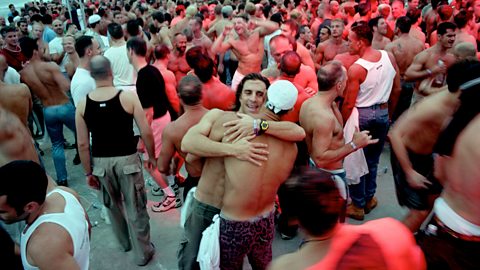Fire Island: A gay paradise of sex and liberation
 Getty Images
Getty ImagesAs portrayed by the hit Hulu rom-com, this iconic destination near New York is the ultimate queer party island. But there's more to it than sand, sea and sex, writes Jack Parlett.
In the new rom-com Fire Island, written by comedian Joel Kim Booster and now streaming on Disney Plus and Hulu, the eponymous island is shown in all its summer glory. Located just a train (and ferry) ride away from New York City, this barrier island off the Long Island coast has been an iconic destination for the queer community since the early 20th Century.
More like this:
A summer season on Fire Island, bookended by Memorial Day (at the end of May) and Labor Day (at the beginning of September), is often eventful. Expect thrills, spills and plenty of parties, followed by excursions to the beach to watch the sun rise above the Atlantic. Loosely modelled on Pride and Prejudice, Kim Booster's film shows Fire Island as a place of contradictions; a space where you can be your authentic self, and let it all hang out among friends, but also an intensely theatrical space, where roles are performed, looks (judgmental, flirtatious) are exchanged, and six-packs are honed.
 Disney+
Disney+While reading Jane Austen one summer on Fire Island, Kim Booster "couldn’t help", he wrote in a recent essay for Penguin, but "map" the experiences of her characters "navigating the limiting social conventions of her time" onto "the similarly tortured social conventions of gay male spaces". In this vein, the film s a long tradition of artworks about the simultaneously loose and restrictive mores of Fire Island, a world associated with both sexual freedoms and social hierarchies. Edmund White, who wrote about a fictionalised version of Fire Island in his 1973 debut novel Forgetting Elena, notes in his memoir City Boy how the rituals of gay social life there "rhymed in my imagination with the rituals of medieval Japan or Versailles".
Still, it is not hard to see why Fire Island's allure has endured across time, and why queer people have ventured there in search of freedom and pleasure. A thin spit of land running approximately 32 miles long and half a mile wide, the island's landscape is visually and ecologically particular, marked with lush vegetation and protected from erosion by sand dunes. Since the 1930s, when artists such as Paul Cus and Jared and Margaret French rented a house in the small community of Saltaire and captured stylish, playful images under their photographic moniker PaJaMa, the beauty of the island’s landscape has offered solace and inspiration. Around the same time, queer and artsy folk from the city were first discovering holiday rentals in the small, rustic community of Cherry Grove, catalysing a process that would come to create what anthropologist Esther Newton calls "America's first gay and lesbian town". After a 1938 hurricane destroyed many of the houses in Cherry Grove, Newton observes in her history of the community, gay men and lesbians bought up much of the lots, then going cheap, from the Long Island families who previously owned them.
 Matthew Leifheit
Matthew LeifheitGoing into the post-war period, Cherry Grove became increasingly well-known as an eccentric, outrageous spot, its small-town atmosphere enriched with a vibrant theatrical and drag culture, and ample venues for drinking, dancing and public sex. The Grove's more upmarket neighbour, Fire Island Pines, was developed later, in the 1950s, as a "family-friendly" community, although this label didn't last for very long, despite the fact that numerous gay homeowners had moved there from the Grove in the hopes that it would act as a more discreet enclave. By the 1970s, with the flourishing of an increasingly public queer culture in the years following the Stonewall riots, Cherry Grove and the Pines were both highly desirable locations, frequented by writers and, including Truman Capote, James Baldwin, Patricia Highsmith, Carson McCullers, as well as numerous stars of stage and screen. That the supposed golden age of Fire Island's loose and liberated culture was so short-lived, before the HIV/Aids epidemic began decimating its community in the early 1980s, only further informs its mythology as a fragile, sacred place, lingering defiantly on the fringes of the Atlantic.
A place of "death and desire"
Because here's the other thing about Fire Island; it is a haunted place. It is, as WH Auden writes in his 1948 poem about the place, Pleasure Island, as if the "lenient amusing shore / Knows in fact about all the dyings". As much as a summer on Fire Island is about immersion in the present moment (this weekend) or the near future (this season), the past is never far away. Scratch beneath the glamorous, hedonistic sheen of its popular image and a rich cultural lineage comes into view, along with the ghosts of the various figures who have graced its shores. Before I began research on my book Fire Island: Love, Loss and Liberation in An American Paradise, which examines the queer cultural history of Cherry Grove and the Pines, while interweaving aspects of personal memoir, I went there in the spirit of pilgrimage, seeking to retrace the footsteps of poet Frank O'Hara, who was killed on the beach near the Pines in a dune buggy accident in the summer of 1966. Standing by the ocean in the early hours of the morning, incanting lines from one of O'Hara's poems, the deathliness of the place became vividly apparent; the sense that it is teeming with the life (or lives) of its past. As the narrator of Andrew Holleran's classic 1978 novel Dancer from the Dance notes, this is a place of "death and desire".
 Getty Images
Getty ImagesThe photographer Matthew Leifheit's series To Die Alive (recently published by Damiani Books), named after a lyric from Ariana Grande's song Break Free, attests to this curious quality in the island's atmosphere. Leifheit captures not only the death site of O'Hara (see image), and of Margaret Fuller, the 19th-Century writer and advocate, whose ship crashed and sunk off the island's shore in 1855, but also the more populated settings of the island's erotic culture. These include the Ice Palace bar in Cherry Grove, originally named after an F Scott Fitzgerald story and home to the weekly Underwear Party, and the Meat Rack, a storied cruising area in the woods between the Grove and the Pines (also known on local maps as the Judy Garland Memorial Pathway.)
If the island's artistic and literary history paints a complicated picture of the place, at once romantic and real, today it remains a contested and continually evolving space. The emergence, over the last 10 years, of artist residency programmes in Cherry Grove and the Pines has helped to revive the island's creative culture and include a more diverse array of queer artists, in an effort to resist its reputation as a majority white space. Recent initiatives have been established in both Cherry Grove and the Pines to address structural inequities in both communities. In the summer of 2021, the photographer Lola Flash presented a series of Fire Island portraits titled We are Here: The Unsung Fire Island, as part of a residency with the arts organisation BOFFO, featuring portraits of queer black and brown residents and visitors. The release of Kim Booster's film, which is seen by many as a landmark in representation, with a central plot revolving around the romantic lives of two queer Asian American characters, further revises the island's dominant narrative.
 Matthew Leifheit
Matthew LeifheitFire Island's freedoms have been hard-won, just as its restrictions and stratifications have been embedded over time, reproducing some of the hierarchies of the mainland world that it seeks to offer an escape from. But in an increasingly fractious era, with LGBTQ+ rights under attack in the US and around the world, locations like Fire Island are vital for retaining and rethinking utopian ideals, just as its imperfections are a reminder of the importance of inclusion when constructing queer spaces. Because it was never just about the sand, or the sea, or the sex, but about finding – and fighting for – a place of our own.
Fire Island is available to stream on Disney+ in the UK and Hulu in the US.
Fire Island: Love, Loss and Liberation in an American Paradise by Jack Parlett is published by Granta Books in the UK and Hanover Square Press in the US
Love film and TV? BBC Culture Film and TV Club on Facebook, a community for cinephiles all over the world.
If you would like to comment on this story or anything else you have seen on BBC Culture, head over to our Facebook page or message us on Twitter.
And if you liked this story, sign up for the weekly bbc.com features newsletter, called The Essential List. A handpicked selection of stories from BBC Future, Culture, Worklife and Travel, delivered to your inbox every Friday.
